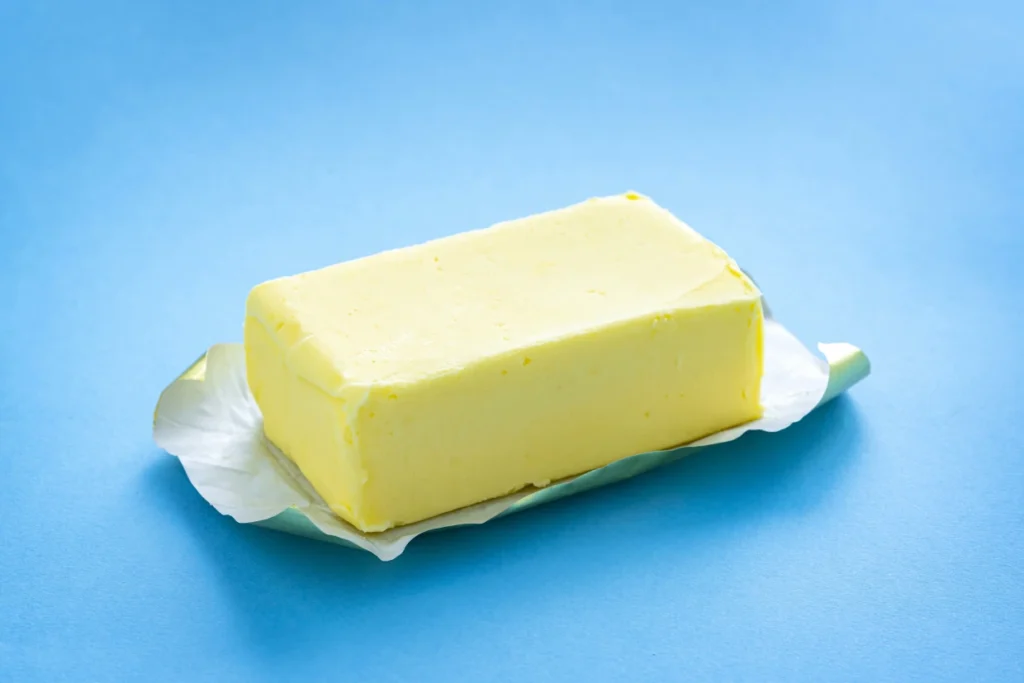Can a Dog Eat Butter? A Comprehensive Guide for Pet Owners
As dog owners, we often find ourselves wondering what human foods are safe for our furry friends. Butter is a staple in many households and frequently used in cooking and baking, but can a dog eat butter? This article aims to address this question, discussing the potential risks and benefits associated with feeding butter to dogs.

What is Butter?
Butter is a dairy product made by churning cream, which separates the butterfat from the buttermilk. It is commonly used in cooking, baking, and as a spread. Butter contains a high concentration of fat, which gives it a rich flavor and texture. It is primarily composed of saturated fats and small amounts of vitamins A, D, E, and K.
While butter can be a delicious addition to human diets, its suitability for dogs is a topic of concern. Let’s delve deeper into whether it is safe for our canine companions.
Can Dogs Eat Butter?
The short answer is yes, dogs can eat butter, but there are several important considerations to keep in mind:
1. Moderation is Essential
While butter itself is not toxic to dogs, it is very high in fat. Feeding your dog large quantities of butter can lead to various health issues, including:
- Obesity: Regularly consuming high-fat foods can contribute to weight gain, which is a significant health concern for dogs. Obesity can lead to conditions like diabetes, joint issues, and heart disease.
- Pancreatitis: Dogs are particularly susceptible to pancreatitis, a condition caused by inflammation of the pancreas. High-fat foods, like butter, can trigger this painful and potentially life-threatening condition. Symptoms of pancreatitis include vomiting, diarrhea, lethargy, and abdominal pain.
2. Potential Lactose Intolerance
Many dogs are lactose intolerant, which means they cannot properly digest lactose, the sugar found in dairy products. While butter contains less lactose than milk or cream, it can still cause digestive upset in sensitive dogs. Signs of lactose intolerance may include:
- Gas
- Bloating
- Diarrhea
- Stomach cramps
If you decide to give your dog butter, start with a small amount to see how they react.
3. Healthier Alternatives
Instead of butter, consider healthier alternatives that can provide flavor and nutrition without the associated risks. Here are some options:
- Olive Oil: A small amount of olive oil can be beneficial for your dog’s coat and skin. It’s rich in healthy fats and antioxidants.
- Peanut Butter: Most dogs love peanut butter! Ensure you choose a brand that doesn’t contain xylitol, which is toxic to dogs. Peanut butter can be a tasty treat or a way to hide medication.
- Pumpkin Puree: Plain canned pumpkin (not pie filling) is a low-calorie option that is high in fiber and can aid digestion.
Benefits of Butter for Dogs
While there are risks associated with feeding butter to dogs, there are also some potential benefits when given in moderation:
1. Flavor Enhancement
Butter can add a rich flavor to dog food, making it more palatable for picky eaters. If your dog is reluctant to eat, a small dab of butter may encourage them to finish their meal.
2. Nutrient Source
Butter contains fat-soluble vitamins (A, D, E, and K), which are essential for various bodily functions. However, it’s important to note that dogs typically get these vitamins from their regular diet. Therefore, butter should not be relied upon as a primary source of nutrition.
3. Occasional Treat
If you choose to give your dog butter as an occasional treat, it can be a special addition to their diet. Just remember that moderation is key, and it should not become a regular part of their meals.
Signs of Distress After Eating Butter
If your dog has consumed butter, monitor them for any signs of distress. Some symptoms to watch for include:
- Vomiting: If your dog vomits after eating butter, it could be a sign of digestive upset.
- Diarrhea: Loose stools can indicate that the butter did not sit well with your dog’s stomach.
- Abdominal Pain: If your dog appears uncomfortable or is whining, it may indicate that they are experiencing abdominal pain.
- Lethargy: Unusual tiredness or lack of energy can signal that something is wrong.
If you observe any of these symptoms after your dog consumes butter, consult your veterinarian for guidance.
How to Safely Introduce Butter to Your Dog’s Diet
If you decide to introduce butter to your dog’s diet, consider the following tips:
1. Choose High-Quality Butter
Opt for organic, unsalted butter without added flavors or preservatives. High-quality butter is less likely to contain harmful additives.
2. Start Small
Introduce butter slowly. Begin with a tiny amount and watch for any adverse reactions. If your dog tolerates it well, you can gradually increase the amount, but always keep it minimal.
3. Use as a Special Treat
Instead of making butter a regular part of your dog’s diet, use it as an occasional special treat. This approach minimizes the risk of health issues associated with excessive fat intake.
4. Consult Your Veterinarian
If you have any concerns about adding butter or any new food to your dog’s diet, it’s always a good idea to consult your veterinarian. They can provide personalized advice based on your dog’s health, age, and dietary needs.
Homemade Dog Treats with Butter
If you’re keen on giving your dog a tasty treat that includes butter, consider making homemade dog treats. Here’s a simple recipe you can try:
Peanut Butter and Banana Dog Treats
Ingredients:
- 1 cup whole wheat flour
- 1/2 cup rolled oats
- 1/4 cup butter, softened
- 1/2 cup peanut butter (xylitol-free)
- 1 ripe banana, mashed
- 1/4 cup water (as needed)
Instructions:
- Preheat your oven to 350°F (175°C).
- In a large mixing bowl, combine the whole wheat flour and rolled oats.
- Add the softened butter, peanut butter, and mashed banana to the dry ingredients.
- Mix until combined. If the dough is too dry, add water a little at a time until it reaches a workable consistency.
- Roll the dough out on a floured surface and cut it into shapes using cookie cutters.
- Place the treats on a baking sheet lined with parchment paper and bake for 20-25 minutes or until golden brown.
- Allow the treats to cool completely before giving them to your dog.
These homemade treats allow you to control the ingredients and ensure they are safe and healthy for your furry friend.
Conclusion
In conclusion, while dogs can eat butter in small amounts, it should not be a regular part of their diet. The high-fat content, potential for digestive issues, and risks associated with excessive consumption make it important to be cautious. If you choose to share butter with your dog, do so in moderation and monitor their reaction closely.
As a responsible dog owner, your priority should always be your pet’s health and well-being. Consult with your veterinarian if you have any questions about your dog’s diet or whether specific foods are safe for them. By making informed choices, you can ensure your dog leads a healthy and happy life with the occasional tasty treat!
